#cogntive functions
Explore tagged Tumblr posts
Text
















The #16types as #Succession insults 💸👌🏻my fav series
Follow me on Instagram, Facebook, Twitter, YouTube and everything else @mbtitime and @typefy
#infp#mbti#infj#entj#intj#enfp#entp#intp#enfj#isfj#succession#succession hbo#succession memes#cognitive functions#myers briggs#16 personalities#16 types#cogntive functions#16 personalidades#16 personality types#istp#istj#estj#esfj#isfp#esfp
67 notes
·
View notes
Text
Germane Cogntive Load
This post is a revisit to previous work on Cognitive Load Theory (CLT) and re-focuses on the germane cognitive load aspect. Germane refers to the work put into creating a permanent store of knowledge, your long-term memory.The germane processes are a function of the learners cognitive resources available and, also are attributible to the learner’s motivation. Germane load refers to the effort…

View On WordPress
0 notes
Text

ok maybe im starting a drawing mbti series, pt one is infp and enfp
138 notes
·
View notes
Text
TBH ENTP #156
and it always occurs to me at like 3am that maybe I should’ve done this work earlier
#mine#text#whoops#entp#mbti#meyers briggs#personality#personality type#intp#intj#entj#tbh-entp#cogntive functions
69 notes
·
View notes
Text
“But it helps to give Allistics a benefit of a doubt”
It aso helps to hit people really hard wenn they are calous, so they remember next time that them beeig callous ... hurts them ... but you don’t see me doing that either ...
Look, I never had to walk an hour to fetch drinking quality water, but I can extrapolate from my own preferences that that is a shit way to start the day and no one should have to do that
Then why can’t I expect the simple “My experence might not be your experience” attitude?
If you can only relate to things you yourself have experienced then you simply lack compation and I will not give you the benefit of the doupt, becasue it doesn’t matter that you didn’t MEAN any harm
I described the feeling of cotton in my mind 20 years ago ... in 2004 ... wenn I noticed how my body was braking down around me
This feeling of a cotton stuffed brain us also called “Brain fog” is a failure in your cogntive function and a symptom of chronic fatigue
So, becaue peopel do not bother to take what I say serious I have been dragging my poor body around for two decades, forcing it to do things it couldn’t which did NOT HELP with the CF at all
So no, if I can not have the common curtesy of beeing listened to and heard, then pray that the only thing i will do is to refuse you the benefit of the doupt
I am beyond angry!
I wouldn’t piss on people like that if they where on fire!
Neurotypicals: Think Autistic people are exceptionally literal.
Autistics: Describe their experiences using phrases like:
My brain feels like it’s filled with cotton laced with barbed wire, it’s not safe for me to make decisions right now.
I’m entering a Wait Mode until we leave.
Just looking at that rotten food makes my skin feel slimy.
Neurotypicals: Assume the Autistics are using metaphorical language to exaggerate common experiences.
14K notes
·
View notes
Photo

Alpha GPC (L-Alpha Glycerylphosphorylcholine) is a choline compound purified from soy lecithin. It is a very effective choline source and a potent nootropic supplement. Choline is a natural precursor to the Acetylcholine neurotransmitter. Acetylcholine is responsible in learning and memory as well as other important cognitive functions. Alpha GPC works great as a supplement by itself or when stacked with racetams or other nootropics. It has also been evaluated as a possible treatment for cogntive diseases like Alzheimer’s and has shown possible results in trials. Function&Application Function 1. Alpha GPC can stimulate the release of HGH naturally and increase Human Growth Hormone (HGH). 2. Alpha GPC can contribute directly to improved mental focus and stimulation of cognitive function; 3. Alpha GPC can permit the development of more strength from work- outs and training programs. 4. Alpha GPC can facilitate methyl group transfers in the brain and liver. 5. Alpha GPC can improve balanced and coordination. Application Alpha GPC is a chemical released when a fatty acid found in soy and other plants breaks down. It is used as medicine. In Europe alpha-GPC is a prescription medication for the treatment of Alzheimer s disease. It is available in two forms; one is taken by mouth, and the other is given as a shot. In the United States alpha-GPC is only available as a dietary supplement, mostly in products promoted to improve memory.Other uses for alpha-GPC include treatment of various kinds of dementia, stroke, and “mini stroke” (transient ischemic attack, TIA). Alpha-GPC is also used for improving memory, thinking skills, and learning. https://www.instagram.com/p/BpXDU7JgE9T/?utm_source=ig_tumblr_share&igshid=1v4xin8l1im5n
0 notes
Link
The Plant Paradox: The Hidden Dangers in ‘Healthy’ Foods That Cause Disease and Weight Gain Dr. Mercola By Dr. Mercola Are you eating a healthy, whole food diet yet still struggle with weight gain and health problems? Part of the problem might have to do with lectins. Dr. Steven Gundry,1 author of "The Plant Paradox: The Hidden Dangers in 'Healthy' Foods That Cause Disease and Weight Gain," makes a strong case for a lectin-free diet. While trained as a cardiothoracic surgeon, Gundry now specializes in treating patients holistically, focusing on food. He's been director of The International Heart and Lung Institute Center for Restorative Medicine for the past 17 years. Before that, he was a clinical associate at the National Institutes of Health, where he invented devices that reverse cell death associated with acute heart attacks. He's also been a professor of surgery and pediatrics at the Loma Linda School of Medicine and chairman of the Department of Cardiothoracic Surgery at Loma University Medical Center. I read about 150 books per year, most of which relate to health. Many of these books I can read in less than an hour, because they're just saying the same old thing. Gundry's bookis not one of those. It's a great resource filled with novel information. What Are Lectins? Download Interview Transcript From an evolutionary standpoint, any creature, including plants, has a built-in imperative to grow, thrive and propagate. Plants, being rooted into the ground, cannot outrun a predatory insect. Instead, plants use chemistry for self-defense. One of the plant kingdom's self-defense systems is lectins — not to be confused with lecithin or leptin. Lectins are plant proteins, sometimes called sticky proteins or glyca-binding proteins, because they seek out and bind to certain sugar molecules on the surface of cells. There are many types of lectins, and the main difference between them is the type of sugar each prefers and binds to. Some — including wheat germ agglutinin (WGA), found in wheat and other grass-family seeds — bind to specific receptor sites on your intestinal mucosal cells and interfere with the absorption of nutrients across your intestinal wall. As such, they act as "antinutrients," and can have a detrimental effect on your gut microbiome by shifting the balance of your bacterial flora — a common precursor to leaky gut. "I like to think of it as they hack into our communication system, or any predator's communication system," Gundry says. "For instance, in insects, they attack a sugar called sialic acid which, among other things, sits between the endings of nerves. One nerve talks to the other nerve by acetylcholine jumping through that space. Sialic acid allows that to happen. Lectins bind to sialic acid and so interrupt nerve transmission. If you think about it, paralyzing an insect is a great defense system because if the insect can't move, bingo, you've solved the problem. One of the things I've learned through the years through my patients is we're just a giant insect to a plant. What may happen to an insect fairly instantaneously by eating some plant lectins may take years in us, who are giant insects, to manifest. It may manifest as neuropathy, it may manifest as brain fog, arthritis or heart disease. But the longer I do this, the more I'm convinced that almost every disease process … can be traced back to … plant lectins. That's a long-winded explanation for how plants don't like us. They absolutely don't want to be eaten. They've had 400 million years to work out defense systems — a really long time." The Role of Your Microbiome One of the things that struck me about Gundry's approach is that it targets the mitochondria and the microbiome, both of which are vital for optimal health. Few physicians, even those in the integrative medicine field, fully understand the importance of mitochondrial function, but Gundry certainly does. And, while the human genome has received a majority of the scientific attention, the bacterial microbiome genome is actually far more important. As noted by Gundry: "Our microbiome is, I think, our early warning system, because about 99 percent of all the genes that make up [the human body] are actually nonhuman, they're bacterial, viral and fungal … [from which] we've uploaded most of the information about interacting with our environment … because the microbiome is capable of almost instantaneous changing and information processing that we actually don't have the ability to do. We're beginning to realize … that the microbiome is not only how we interact with plant materials … like lectins, but probably more importantly, our microbiome teaches our immune system whether a particular plant compound is a friend or foe [based on] how long we've known that plant compound. There are lectins in everything. But the longer we've interacted with lectins and the longer our microbiome has interacted with them, the more our microbiome kind of tells our immune system, 'Hey, guys, it's cool. We've known these guys for 40 million years. Chill out. They're a pain, but we can handle them.' From an evolutionary perspective, if you look at modern foods — say the grains and the beans, which we started interacting with 10,000 years ago, which is a blink of time — our microbiome [regards them as] foreign substances … [T]here's no lectin speed dating in evolution." The Importance of Mitochondrial Function With regard to mitochondria, "mitochondrial flexibility is one of the unique things that make us human," Gundry says, comparing the human race to a "fat-storing ape." Whether you ascribe to the evolutionary theory or not, humans and apes have many genetic similarities, but the ability to store fat is a unique human feature. No other great apes can do that. Chimps, gorillas and orangutans carry 3 percent body fat. Few humans could ever achieve that low of a body fat percentage unless we were near death from starvation. "The reason we're designed to [store fat is to] be able to access fat for fuel," Gundry says. "The reason why [humans] have been able to take over all parts of the world … [is] because we can cycle back and forth, having our mitochondria use fat for fuel or glucose for fuel. We're designed to shift very quickly … even within 24 hours. [Most people] no longer have that metabolic flexibility [because] we've been constantly bombarding our mitochondria with an overload of glucose as a fuel, and that really underlies, I think, most disease processes." How Intermittent Fasting Boosts Mitochondrial Flexibility One of the strategies Gundry recommends and uses to improve his own metabolic flexibility is intermittent fasting. For nearly a decade now, he's been fasting for 22 hours a day, five days a week, from January through June 1, which means he eats all his calories for the day during a two-hour window. On the weekends, he eats lunch and dinner. "I don't eat breakfast. I don't eat lunch. I eat my calories between 6 and 8 o'clock at night. I do that because my wife and I are at home at that time. If I was really smart, I would [eat] earlier in the day, but, you know, you've got to be practical in one way or another … In summer, I'll have a smoothie with some MCT oil in it, half an avocado, some romaine lettuce, spinach, half a lemon and a little bit of vanilla or stevia. Then I won't eat lunch. At dinner, same sort of thing, I try to pack all of my calories in between 6 and 8 o'clock at night … [June 1], I finished my winter fast, if you will. Now, why do I do that? [Historically], food was a rare thing to find [during the winter]. Again, our metabolic advantage is we're really good at starvation. It's what allowed us to survive. We know that during food scarcity, not only do our mitochondria rev up, but more importantly, our entire immune system and genetic monitoring basically says, 'Look, times are tough. We don't know when the next good food supply is going to come. We've got to make it through to that next period. We're going to look at every cell in our body. We're going to look at whether they're pulling their own weight. Are they odd? Are they not very fuel-efficient? We're going to jettison that. We're going to create apoptosis until these cells commit suicide.' It's kind of like if we were in a hot air balloon and we're heading for the mountain and we're going to crash, we've got to start throwing things overboard to get more lift. I think that's a fundamental principle that you've known for a number of years and that I've certainly preached for a number of years. The more we understand that that's how successful aging occurs and study successful agers, one of the things that's fascinating, particularly in an animal model, is that this intermittent fasting, this challenging [your mitochondria], is the way to do it." Although I used to do 14- to 16-hour intermittent fasts, because I felt that it was wise to increase glycogen stores prior to strength training, I have come to realize that's not true. In fact, it's counterproductive, as carbs after strength training can increase insulin and diminish IGF-1 response and blunt the anabolic stimulus. So now I am fasting for 18 to 20 hours a day and do all my strength training in a fasted state. That may sound challenging, but I can confidently assure you, from personal experience, that once you are fat adapted there are no cravings. Additionally, I recently interviewed Dr. Dale Bredesen, who wrote the book "The End of Alzheimer's: The First Program to Prevent and Reverse Cogntive Decline," in which he discusses how ApoE4 is a genetic risk factor for Alzheimer's but ONLY if you don't intermittent fast. If you do, it will likely actually decrease your risk for the disease as its biological function is to allow us to go for longer periods of time without food. The Importance of Ketogenic Cycling Gundry also understands the importance of cycling in and out of nutritional ketosis. While your body is still burning sugar as its primary fuel, you'll want to be quite strict about not going over your net carb allotment. But once your body has regained the metabolic flexibility to burn fat, it's really important to cycle in and out or on and off. I suggest doubling, tripling or even quadrupling your net carbs two days a week, because the metabolic "magic" actually happens during the refeeding phase. As noted by Gundry: "You have to look at it evolutionarily. It really was feast or famine. When we hit large amounts of food, whether it was a fruit tree or whether it was honey or a wildebeest or a mastodon, there was no food storage system. People tend to forget that nobody walked out of their cave and said, 'What's for breakfast?' There was no refrigerator to have organic berries in every day. When we chanced upon fuel, then our beautiful design [allowed us to] eat large quantities of [food] and store it as fat. Because, very shortly, whether it was a period of drought, whether it was a period of winter, we were going to regress. I'd like people to think of circadian rhythms. Obviously, we have a 24-hour clock. We have a moon clock. We have seasonal clocks. What I like people to think of is that we have a period of every year where [we're in] a growth cycle … That's the time of growth and it's a time to reproduce. Then there's a time of involution, whether it's a tree dropping its leaves, whether it's an animal hibernating. That's the time where we kind of take stock of everything. That yin and yang, that flow that would happen every year on seasonal basis has completely been lost. We have to have periods where we consume excess calories, then we have to have periods where the exact opposite happens. Years ago, after my first book came out, I was invited to Phoenix, Arizona, by a blogger named John Kiefer. Kiefer said you should burn fat for fuel most of the time. But every week, you should have what's called "carb nite loading." He chanced upon this by accident, but he made a career out of it. I picked his brain and he picked my brain. I think he's absolutely right." Lectins Are Strongly Associated With Autoimmune Diseases of All Kinds Since we just talked about carb-loading at least once or twice a week (once you've regained the ability to burn fat for fuel), it's worth stressing that these ought to be healthy carbohydrates, and ideally lectin-free. While intermittent fasting and eating a ketogenic (high-fat, low-carb, moderate protein) diet will dramatically reduce your risk of chronic disease, lectins may still cause trouble. One of the primary issues is autoimmune diseases. "One of the things I talk about in the book that really made me hyper-focused on lectins was a friend of mine who was a very early adopter of my first program. I call him Tony in the book. Tony had really bad vitiligo. That's … where the [skin] pigmentation is lost. Vitiligo is an autoimmune disease. What happens is we attack the pigment-forming cells in our skin called melanocytes. Melanocytes are actually modified neural cells. They migrate from the neural crest to our skin in embryonic development. When Tony started my program, a few months later, he came up to visit me. He said, 'You're not going to believe this. My vitiligo is gone.' I'm looking at him and I'm going, 'Wow. That's impressive.' He said, 'How did that happen?' I could have said, 'Well, this is a very anti-inflammatory diet. It's high in antioxidants.' But because I'm a researcher, I said, 'No. That's too simple.' I said, 'Melanocytes. Neural Cells. What's the target of lectins in insects? Neural cells! Could it be that lectins are why [his body is] attacking his neural cells? What I've done is I've removed lectins from his diet.' I lost track of him for a number of years. I was on a health panel in New York City two years ago. I saw him and he's covered with vitiligo again. I said, 'What happened?' He says, 'You know. I fell off [the diet]. I really need to get back on.' I said, 'This is a great experiment. Come on. Here's the list. Go for it.' We were just on a panel at Harvard two months ago. He's chairing the panel. He says, 'I've got to show you — everybody — the vitiligo's gone because I took lectins back out of my diet. It sounds silly but here's the proof.'" Molecular Mimicry One way by which lectins cause harm is through molecular mimicry. They resemble proteins in the thyroid gland, in your joint spaces and in nerves. They mimic myelin sheath proteins. The reason why lectins will in one person cause vitiligo or psoriasis, and in another attack the thyroid or cause rheumatoid arthritis, is still unknown. What is known is that one of the underlying factors in all of these disease processes is the penetration of the gut wall by lectins and their co-travelers, lipopolysaccharides (LPSs), also known as endotoxins, which tend to elicit very strong immune responses. "One of the things I found in all my autoimmune patients is they had profoundly low levels of vitamin D … Interestingly, when you finally seal the gut … all of a sudden, their vitamin D levels went sky high and I could back down on the dosage. Vitamin D is essential to tell the stem cells at the bottom of the crypts in the villi to grow and divide. Without vitamin D stimulating them, they just sit there and don't repair the gut. I think plants are so intelligent, it's shocking. I think one of the plant strategies is that if you have low vitamin D, because you can't absorb it, then you can't repair your gut. You're a horrible predator. You won't reproduce. You won't walk. Vitamin D is really one of the keys to autoimmune disease. Lectins are the other key. I've been blessed by knowing thousands of autoimmune patients who I call "canaries," because they react almost instantaneously to lectins. It's interesting. Everybody has their own certain lectin or lectins that they really react to. This morning I had a woman who has rheumatoid arthritis. Her rheumatoid markers or anti-CCP3 markers have gone up. Her IL-17 had gone up. I said, 'All right. What are you doing? What's going on?' She said, 'No, no. I'm perfect. I know your list backwards and forwards.' I said, 'No. There's something.'" A Sample Case History of Crohn's Disease As it turns out, she's been eating raw (unpeeled) almonds, and almond peels contain lectins. Another patient's markers went up after going on a cashew binge, forgetting that cashews are an American bean and hence high in lectins. The answer for autoimmune patients, Gundry says, is to remove lectins from the diet and add vitamin D, which together will help "heal and seal" the gut, thereby preventing the autoimmune response. "I mention a young woman who has Crohn's disease in the book. Her well-meaning doctor at the Mayo Clinic told her that food had nothing to do with Crohn's disease. She had been cured of Crohn's disease with my program. He told her it was the placebo effect. We still laugh at that one. She ate a couple of Christmas cookies after she got off the phone with him. Of course, it was like throwing a bomb in her stomach. She had horrible cramps and diarrhea. We skyped and she said, 'Why don't doctors see this?' Like I talk about in the book, we can't see unless our eyes are open … I was lucky enough that when I met the guy who changed my life, Big Ed, who cleaned out his arteries with diet and supplements, [I had] my eyes open. I said, 'This is not chance. How did [he] do this?' Luckily, because of my evolutionary background, I was able to piece it together." Which Foods Have the Most Problematic Lectins? Lectins are found in many of our most cherished foods, such as: 2,3 ✓ Potatoes ✓ Eggplants ✓ Tomatoes ✓ Peppers ✓ Goji berries ✓ Lima beans ✓ Cashews ✓ Peanuts ✓ Sunflower seeds ✓ Chia seeds ✓ Pumpkin seeds ✓ Kidney beans ✓ Squash ✓ Corn ✓ Quinoa ✓ Soybeans ✓ Wheat ✓ Lentils Another common lectin is the A1 casein protein, found in most of today's dairy cows. I've talked a lot about the benefits of raw milk on my site. The devil's in the details however, and aside from being high in sugar, even raw dairy may cause problems if it has A1 casein. "Casein A2 is the normal protein in milk, besides whey. It's present in sheep, goats and water buffalos. But, most of the cows in the world are now casein A1 producers. They make a lectin-like protein called casein A1, which is metabolized in our gut to make beta-casomorphin, which is a very interesting thing. They can attach to the beta cell of the pancreas and incite an autoimmune attack on the pancreas. I and others are pretty convinced that [many cases] of Type 1 juvenile diabetics is because of the casein A1 in milk. I've been convinced through the years that not only is it the problem, but people who think they're lactose intolerant or that milk gives them mucus, it's the casein A1 … Raw milk is great, as long as it came from the right cow … [Some] Jerseys are A1 and [some are] A2. Holsteins are A1." More and more people are now starting to recognize this, and there are even grassroots movements pushing for A2 milk in California and Ohio. Jeni's Ice Cream gets all her milk from Snowville Creamery, which is an A2 farm. "I've actually talked to those people. They get it," Gundry says. There have even been attempts to introduce A2 milk on a larger scale, but each attempt has been crushed by the American Dairy Council, for obvious reasons. Wheat — Going Beyond Gluten Wheat germ agglutinin (WGA) is another problematic lectin, found in wheat. Compared to WGA, gluten is a minor problem. According to Gundry, WGA is one of the most efficient ways to induce heart disease in experimental animals. WGA binds to insulin receptor sites. Normally, a normal hormone will dock on a receptor site, give its information and then release. Pseudo hormones like WGA, on the other hand, dock on the receptor permanently. Gundry explains: "If they hit the insulin receptor on a fat cell, they turn on lipoprotein lipase and pump sugar into the fat cell, turning it into fat constantly. In muscle cells, the exact opposite happens. They'll attach to the insulin receptor in the muscle cell [and] block insulin from delivering sugar into the cell. I see so many long-distance runners who are carboholics, who look like concentration camp survivors because they're really cachectic and sarcopenic because they block the insulin receptors in their muscles … The lectins, like WGA and galactans in beans are miraculous ways of making us store fat … [T]he only way we've ever been able to fatten an animal for slaughter is to give them grains, beans and some antibiotics. If that's how we fatten animals, that's how we fatten us. It works really well." Not All Bread Is the Same If you've ever traveled to Europe, you may have indulged in some bread and noticed you didn't experience the same type of problems you have when eating bread in the U.S. The reason for this is because the lectins are removed when you use traditional methods of raising bread, which is still popular in Europe. "Europe [has] always used traditional methods raising bread. They use yeast or sourdough. Yeast and bacteria are actually pretty good at breaking down the gluten molecule and other lectins," Gundry explains. Europe also does not permit the use of glyphosate to desiccate wheat, which has become common practice in the U.S. Glyphosate is also used on many conventional grains, including beans and flax, so it's in the animal meats we eat, it's in our baked goods, and even in wine produced in the U.S. According to Gundry, glyphosate potentiates gluten to people who are not even gluten-sensitive, and interferes with your liver's ability to manufacture the active form of vitamin D. Glyphosate also chelates important minerals, disrupts the shikimate pathway, decimates your microbiome and increases leaky gut, which allows more of the LPSs into your bloodstream. Since it works synergistically with the lectins, it really delivers a double-whammy. "[Glyphosate] hits cytochrome P450. It's one of the reasons the Europeans are so far [ahead] on health," Gundry says. "It's one of the reasons why so many of my patients can go to Europe, eat their traditional diet and think they're cured and now they can start eating bread. They come back and eat a piece of bread and, bam — the whole thing starts all over again." On Vegetarianism and Other Diets As mentioned, Gundry was a professor at Loma Linda University, a Seventh Day Adventist facility. Seventh Day Adventists are typically vegetarians, and while not an Adventist, Gundry did eat a vegetarian diet for about 15 years during his time there. "I've never been sicker in my life. I used to weigh 228 pounds despite running 30 miles a week and running half marathons on the weekend and going to the gym one hour every day, wondering why I had high blood pressure, prediabetes and heart disease … Quite frankly, we have a fabulous orthopedic department at Loma Linda, because grains are pretty doggone mischievous for that. Through the years, I've been good friends with the head of the Adventist Health Studies, a cardiologist. One of the things I've learned from following the Adventists and following Gary Fraser is that … certain animal proteins do contribute to aging. In the Adventist health study, the vegan Adventists have the longest life span. Behind them are the lacto-ovo vegetarians, then behind them are the pescetarians. Then finally, there are the real cheaters who eat chicken … It is interesting that the longest living of the Adventists, who are very long-living, are the vegans. I take care of a lot of vegans because of my association with Loma Linda. As a general rule, the vegans are some of the unhealthiest people I have met. The reason is they're grain- and bean-itarians. They are not vegetable eaters. I have nothing against a high vegetable diet … The other thing we see in the vegans is they somehow think they will convert short-chain omega-3 fats into EPA, the long-chain omega-3 fats. They absolutely and positively do not. Our brain is about 70 percent fat; 50 percent of that fat is DHA. There are beautiful longitudinal studies showing people with the highest omega-3 index have the largest brains as they age, and the largest areas of memory in the hippocampus. People with the lowest levels of omega-3 index have the most shrunken brains and the smallest areas of memory. Vegans have no excuse anymore. There's algae-based DHA." Fruit and Berries — Seasonal Treats Gundry's first rule is that what you stop eating is more important than what you start eating. "It's absolutely true," he says. "If you take away certain foods, you'll be amazed [to find] that it's certain foods that are the troublemakers." His second rule is, take care of your gut microbiome. Rule No. 3 is "fruit might be as good as candy." While he doesn't expound on the importance of burning fat for fuel in his book, that's really part of the equation. Once you're able to burn fat, fruit can be a healthy carbohydrate to add once or twice a week. "Exactly. I think part of the problem is the vast majority of Americans are insulin-resistant. One of the things that people should realize is that the modern fruit has been bred for sugar content … One of the things I ask people to do initially is give fruit the boot. Fructose is a major toxin. We take fructose directly to our liver and detoxify it into triglycerides and uric acid. It always amazes me the number of people with gout who consume more concentrated fruit, like wine or beer. Beer is one of the underlying reasons that they have gout. The other thing people should realize is that fructose is a direct renal toxin. The more fructose I can get out of people, the better. Having said that, once you get to a point where you have metabolic flexibility, I think things like berries are probably one of the best ways to carbohydrate load on the day you decided to do that … Sweet potatoes are great as well, [and] I'm a big fan of taro root. Years ago [in June] … my wife and I were at a Santa Barbara farmers market. I was taking these gorgeous organic peaches and putting them into my bag. She says, 'Hey, wait a minute. Aren't you the guy who says give fruit the boot?' I said, 'Yeah, yeah. But it's June and it's time to eat fruit.' She says, 'OK, smart guy. Let's do this. This summer, we're going to give up fruit to see what happens' … So, we gave up fruit for one summer. We didn't change anything else in our diet. My wife lost 6 pounds and I lost 8 pounds. It brought home to me that, again, our ancestors and the reason we have two-thirds of our tongue devoted to sweet taste is we are great fruit predators. Fruit was only available once a year. We utilized that fruit to gain weight for the winter … [Now] we can have it 365 days a year, but that's not normal. So, always keep that in mind." More Information To learn more, I highly recommend picking up a copy of "The Plant Paradox," especially if you've already cleaned up your diet and still struggle with excess weight and/or health problems. Certainly, anyone with an autoimmune disorder would be wise to take a closer look at lectins. It's really vital information that can help optimize your health, and that of your family. It's a great read, with the perfect balance between science and practical recommendations. If you've been following the "Fat for Fuel" approach, it's just a minor tweak. But it's a very important tweak that I wish I would have known about earlier. If I had, I would have dedicated a chapter to lectins in my book. I will however incorporate this information in my "Fat for Fuel Cookbook," which will be published this fall.
0 notes
Text
Kurisu Makise (Steins;Gate)-INTJ

Introverted Intuition (Dominant Position): At the beginning of the series, Te-Fi are the only characteristics that are portrayed in her personality. However, Subjective Intuition comes to light when she analyzes the concept of time - a theme of Ni itself. She develops a perception of the different timelines, ruminating on how this works; To quote her exact words: “Time is passing so quickly. Right now, I feel like complaining to Einstein. Whether time is slow or fast depends on perception. Relativity theory is so romantic. And so sad". At the ending, she realizes where Okabe disappeared to and rushes after him, becoming worried when he was gone for a long time, and thus saves him in the desert. Sense of Time is a theme of introverted intuition, and although this feature is mostly discussed in socionics Ni, it explains how NJs and their perception of how upcoming events are destined to unfold in the future.
Extroverted Thinking (Auxiliary Position): Kurisu is highly rational most of the time, and prioritizes with her knowledge of logical pursuits of time travel and neurology - this is clearly a strength in her personality. She uses the external facts about the science she has learned to experiment with the idea of time travelling the consciousness of the mind, creating the headphone that could pick up brain activity. She joins Okabe’s “Lab” to continue with her scientific theories of time and develops techniques using her extroverted logic.

Introverted Feeling (Tertiary Position): As a scientist Kurisu doesn’t want to let her emotions get in the way, and therefore she represses them. She is extremely private with her feelings, and has a strong negative reaction when Okabe catches her in moments of wanted privacy, such as her online posts or her attempt at calling her father. She often reacts based on her own subjective feelings of like and dislike e.g. showing an annoyance to Okabe’s nicknames he gives her. Her focus on feeling is based on her relationships towards individuals, enthusing to Mayuri about how important she is to Okabe, and making an effort to reconcile with her father. She is aware of personal connections and how this affects perception of time ( "People's feelings are memories that transcend time.")
Extroverted Sensing (Inferior Position): Throughout the series, scenarios that involve Se experience is rare, as it focuses on the concept of time travel more than the present - but there are moments which show Kurisu’s weakness of Se. Although she usually has a calm and collected outer persona, Okabe overwhelms her with his outbursts, and this even pushes her to tears - she always responds with shock or blushing when her feelings or values are violated. However, her perception is still orientated towards seeing reality as it is, only she thrives more on abstraction.

37 notes
·
View notes
Note
I feel bad because I'm sure you get this a lot, but alas my curiosity is getting the best of me. I am for sure ENTP, but I always start to doubt if I'm an lazy entj, or an entp that has their shit together (somewhat). I say this because I know my Ne is so so so strong (I love love love everything. Literally. Everything.), but Te is also always very very strong when I test for it. Any thoughts?
I have that with a few functions, it just means you’re healthy! We all use 8 functions, so we may as well work to develop the ones that aren’t in our stack. You can have your functions developed in a strange order, but the prevalent stack is your type. Observe my results from the similar minds test:
Ne (Extroverted Intuition) (100%) your valuation of / tendency towards free association and creating with external stimuli
Ti (Introverted Thinking) (75%) your valuation of / adherence to your own internally devised logic/rational
Ni (Introverted Intuition) (70%) your valuation of / tendency towards internal/original free association and creativity
Se (Extroverted Sensing) (65%) your valuation of / tendency to fully experience the world unfiltered, in the moment
Te (Extroverted Thinking) (35%) your valuation of / adherence to logic of external systems / hierarchies / methods
Fe (Extroverted Feeling) (35%) your valuation of / adherence to external morals, ethics, traditions, customs, groups
Fi (Introverted Feeling) (30%) your valuation of / adherence to the sanctity of your own feelings / ideals / sentiment
Si (Introverted Sensing) (25%) your valuation of / focus on internal sensations and reliving past moments
14 notes
·
View notes
Text
I'm INTJ. What about my followers?

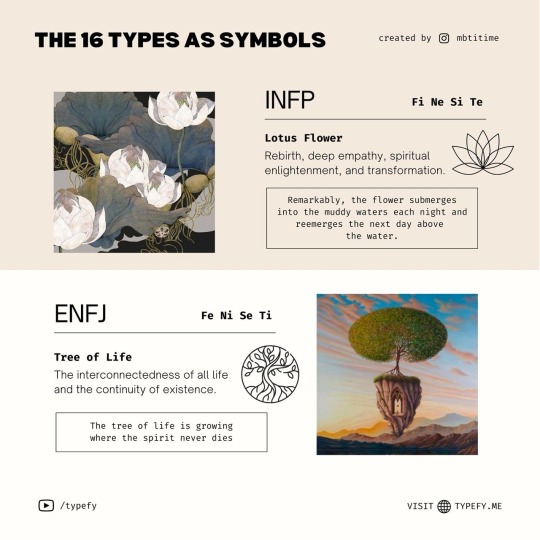
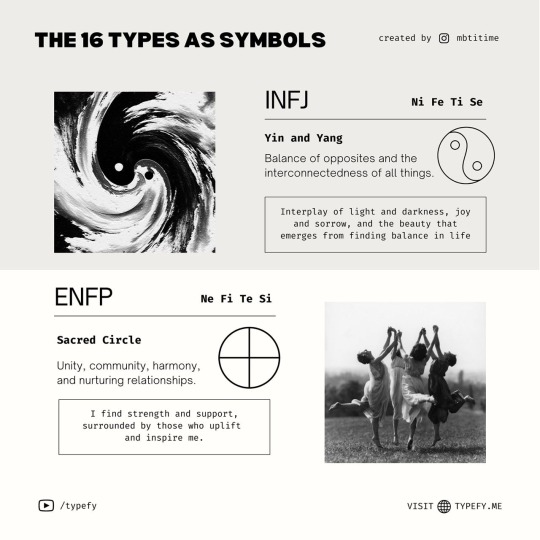
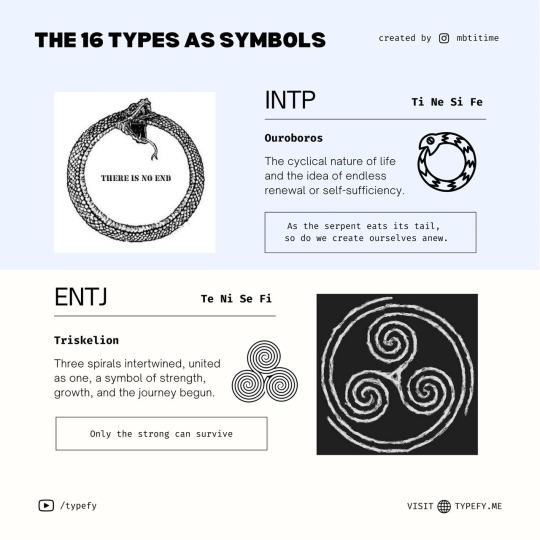
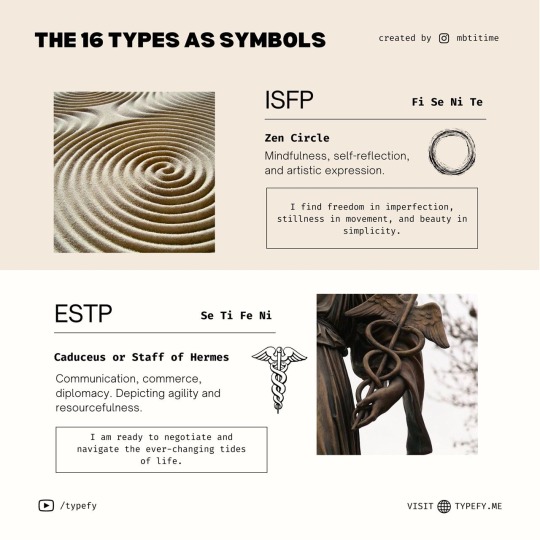
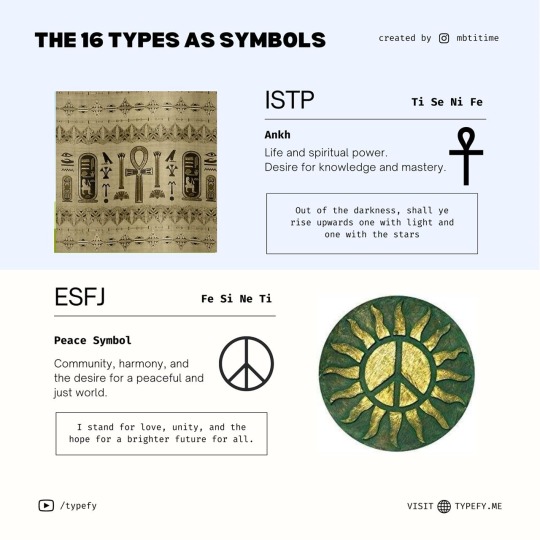

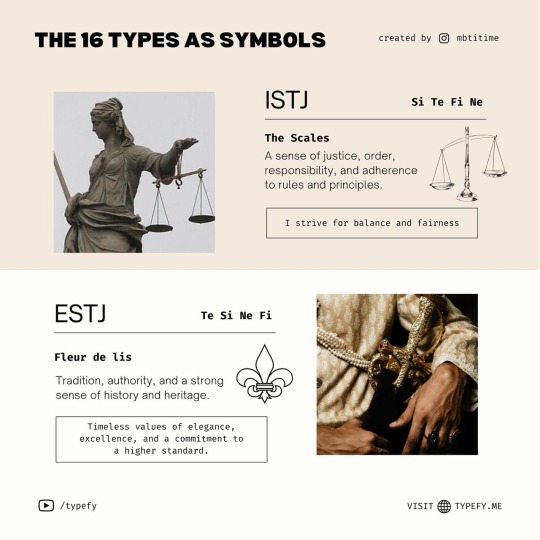
The 16 Types as Symbols
Follow me on Instagram, Facebook, Twitter, YouTube and everything else @mbtitime and @typefy
#infp#mbti#infj#entj#intj#enfp#entp#intp#enfj#isfj#istj#isfp#istp#estj#estp#myers briggs#esfp#esfj#16 personalities#16 personalidades#cogntive functions#carl jung#symbols
4K notes
·
View notes
Note
hello friend do you mind describing each type as a teenager? it was my understanding that during this time they started developing(? giving importance? using?) the tertiary function and i'm having trouble picturing it (especially the perceiving fuctions)
Hello hello i am so sorry i took forever to answer this
Yes, you are correct, most people develop their Tertiary function in their teen years. I’ve also noticed it is how they have fun. The examples i am going to use are going to be of someone who developed their 3rd function pretty well so it won’t apply to everyone.
INFJ: Will probably become interested in a some kind of logical theory that pertains to connections and how people work. In my case, it was Myers Briggs. They may come off as overly analytical at times. Will probably talk enthusiastically about the theory they are interested in.
ESTP: Will probably start to develop the manipulation part of their Fe first and start to be able to use their understanding of people to get them to do things. They may also focus on entertainment and use their Fe to make jokes that appeal to the crowd.
INTJ: Will probably brood a lot and stew in their own emotions by themselves, over analyzing their own emotions and trying to rationalize them.
ESFP: Will probably enjoy debating with people in order to have fun
INFP: Will probably be really nostalgic and think about the emotional meaning behind their experiences
ESTJ: Will probably do things the way they’ve always been done, but with a twist. They use the foundation of a conventional idea and then add in a little ingenious idea that makes everything work.
INTP: Will probably use their Si to store random information and details about theories that interest them
ESFJ: Will probably use their Ne to be a little quirky and will use it in their humor to get along with people
ISFJ: Will probably over analyze their past experiences and try to pull inferences from them
ENTP: Will probably develop a lot of manipulation first and learn to skillfully control people when they are bored, and basically just use Fe to be likable and get away with being a jackass sometimes
ISTJ: Will probably constantly wallow in their past experiences and get really emotional about them
ENFP: Will probably debate a lot in order to fiercely defend their values
ISFP: Will probably just get really chill and start being that one person who eats smoothies and meditates
ENTJ: Will probably start being even more efficient somehow and implement their ideas as soon as they come to mind. They will probably get into sports or art or something else physical as well.
ISTP: Will probably get more interested in logical theory and analyze and dissect everything
ENFJ: Will probably get even more bubbly and eclectic, becoming spontaneous and less serious.
#mbti#answered#tertiary function#cogntive functions#development#myers briggs#mine#INFJ#INTJ#ESTP#ESFP#INFP#ENTP#ISTJ#ISFJ#ESTJ#INTP#ESFJ#ISFP#ENTJ#ISTP#ENFJ#Ni#Se#Fi#Te#Ne#Ti#Fe#Si
836 notes
·
View notes
Text

this right here is the most accurate and legit mbti online test i’ve seen: (X)
#i find it impossible to take these bc i know what function each ? is getting at#but i just clocked nuetral if i didnt have a clear preference#still got this#ive gotten infp some but feel like this test is v skewed toward introverted functions#my Ti and Fi alwyas come out pretty high on every#cogntive functions test i do#anyway interesting to do regardless of reliability#Si..... i dont compute#htf did i get higher Si than Se
129 notes
·
View notes
Text
RIP Queen Elizabeth I

Commemorating Queen Elizabeth II — some wisdom we can learn from the longest-lived Queen in Britain #ISTJ🇬🇧
Follow me on:
Instagram, Youtube, Reddit, Twitter, Medium 👉🏻 @ mbtitime and @ typefy.me
Wanna know your type? Book now.: http://typefy.me
#mbti#16types#queen elizabeth#britain#16 personalities#myers briggs#istj#intp#intj#isfj#cogntive functions#16 personality types#16 personalidades#entj#estj#entp#estp#esfj#esfp#infp#infj#isfp#enfp
30 notes
·
View notes
Text
Leliana (Dragon Age) - INFJ

Introverted Intuition (Dominant Position) Leliana speaks confidently about her perceived “vision” that she confesses was a sign from the Maker, as she found an impossible white rose on a dead bush in Lothering, and when the Grey Warden arrives she believes it was meant to be. Her Vision spurs her passion to aid the Warden in the Fifth Blight, and she has a strong determination to stop evil and bring hope to the world. As an adviser she plots and schemes in the shadows, and tells the inquisitor when she has a lead on suspects in the Orlesian court. In the Orlesian court, Leliana reveals that observation of what a person is wearing can uncover many hidden truths about the person, as it can indicate the current situation and happenings of the Noble’s life, and the events which could follow. When the question of the next divine arises after Justinia’s death, Leliana becomes inspired by her vision and goals to reform the Chantry entirely, based on the injustices from the past conflicts.
Extroverted Feeling (Auxiliary Position) After the death of the divine, Leliana hardens and her demeanor becomes cold. However, Leliana is diplomatic and takes an interest in court intrigue, showing willingness to play the game. She knows how much to show people to cultivate the responses she wants. If enlightened by the Inquisitor she becomes inspired to give hope to everyone of all races.

Introverted Thinking (Tertiary Position) Leliana becomes reserved and analytical, which was a noticeable difference from her enthusiastic and caring nature she had in the events of Origins. At the beginning she was intensely religious, but after Divine Justinia’s death, this brings her to question the meaning behind it, seeing no logical or moral sense in this. As a plan for being the Divine, Leliana is driven by the prospect of creating her own laws and rules for the Chantry.
Extroverted Sensing (Inferior Position) Due to negative influence which affects her morale and empathy, Leliana resorts to an unhealthy impulsiveness and ruthlessness in her actions, refusing to abide by the rules so her network of spies can run more smoothly. When one of her spies betrays her, her impulse is to kill the man for his crimes. In the Inquisitor’s future in Redcliffe, she murders Alexius’s son to provoke him into action which was motivated by her own anger. If hardened by the influence of the Inquisitor, she firmly believes in the “kill or be killed” rhetoric, and will commit any action in her power to protect the inquisition.
30 notes
·
View notes
Text
Lastest test gave MBTI INTP

And I have an Ouroboros tattoo 😅









The 16 Types as Symbols
Follow me on Instagram, Facebook, Twitter, YouTube and everything else @mbtitime and @typefy
#infp#mbti#infj#entj#intj#enfp#entp#intp#enfj#isfj#istj#isfp#istp#estj#estp#myers briggs#esfp#esfj#16 personalities#16 personalidades#cogntive functions#carl jung#symbols
4K notes
·
View notes